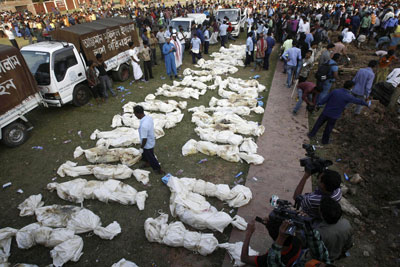Fire in Bangladesh Garment Factory Kills 121 people:
If your shirt could talk. . .
December 9, 2012 | Revolution Newspaper | revcom.us
Download poster of this article

Photo: AP
On November 24, 2012, 121 garment workers died and at least 200 were injured in a fire at the Tazreen Fashions factory in Ashulia, an industrial suburb outside Dhaka, Bangladesh.
On November 24, 2012, 121 garment workers died and at least 200 were injured in a fire at the Tazreen Fashions factory in Ashulia, an industrial suburb outside Dhaka, Bangladesh. The nine-story building had no fire escapes, the ground floor exits were locked. Tazreen is part of the larger Tuba Group, which makes apparel for top global retailers like Carrefour, Walmart, H&M, Tesco, IKEA, C&A, Gap, and Sainsbury’s. In Bangladesh, about 600 workers have been killed in fires like this since 2006. Two million workers, mainly women, are employed in the country's 4,500 garment factories. Among the lowest paid in the world, Dhaka's garment workers sometimes earn less than a dollar a day. (Go to revcom.us for the article "Bangladesh workers burned alive in death-trap garment factory")
The fundamental thing that enables human beings to live and have society is the exchange of labor among people, but this is not at all obvious.
“If you go to work, you put in a certain amount of work, you get back a certain amount of money in exchange for that work. You go buy certain products at the store or whatever and then you take them to your house and use them and you exchange things in that kind of a way. This goes on in such an everyday way that we don’t even stop and think about it. But you are actually exchanging things indirectly through all these different stages with people all over the various parts of the globe.
“Think about it this way. Don’t do it right now, but when you go home, check out your clothes. Look at the labels on them. Don’t just look at where it says what company, brand is on the clothes. But look where it says where these clothes or other things you have were made. In Nicaragua, in Honduras, in Haiti, in Pakistan, in Egypt, all over the world. We are exchanging things and ultimately and fundamentally we’re exchanging labor. People in those countries are putting in a certain amount of labor and we’re putting in a certain amount and that’s being exchanged through the form of the way in which we buy things with money. But it’s not very obvious because partly they want to keep it hidden from us. And the other reason is there are things that get in the way of our seeing that very clearly. First is the fact that there are all these intermediate steps. We’re not the six people directly exchanging labor with each other. We’re exchanging money getting something, the remote character of where it came from is not obvious unless you do go read those labels, for example. So that’s kind of one thing that keeps it hidden from us is that here’s somebody working in a sweatshop in Pakistan making a shirt that you wear and you’re over here putting in a certain amount of work so that you get the money to be able to go to buy that shirt when it gets to a store that you go to. You’re exchanging the labor you put in for the labor they put in to make that shirt. But it goes through so many stages in between that you don’t see that.”
From Revolution: Why It’s Necessary, Why It’s Possible,
What It’s All About, a film of a talk by Bob Avakian,
from the section “What Is Capitalism?”
(available online at revolutiontalk.net)
If you like this article, subscribe, donate to and sustain Revolution newspaper.